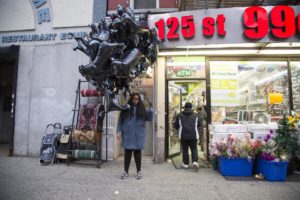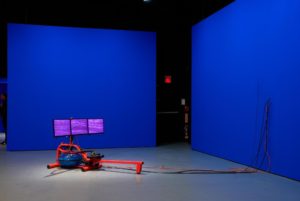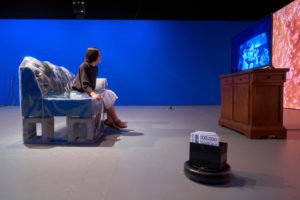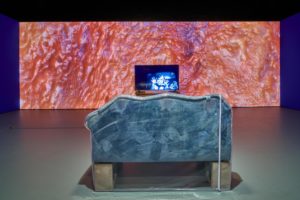[January 12, 2022 | Season 2, Ep. 6 | Barbara London Calling]
Barbara London: Today I’m speaking with Sondra Perry, an interdisciplinary artist born 1986 in Perth Amboy, New Jersey. Sondra creates insightful artwork using video, computer-based media, installation and performance. She is one of today’s bright, young stars, highly respected as an innovator. Technically adept, with wit and grace she investigates such timely topics as desire, race, power and gender. Sondra, welcome to Barbara London Calling 2.0. I’m delighted to talk with you today.
Sondra Perry: Thanks for the invitation, Barbara. This is really cool.
[Continue reading for full transcript.]
Transcript
BL: You did your undergraduate degree at Alfred University in upstate New York, where the school’s Electronic Integrated Arts department pays particular attention to the nitty-gritty of the electronic signal. I believe you’ve even returned to teach and take workshops there over the years. Tell me a little bit about your time at Alfred and what lessons you learned.
SP: Being at Alfred was really interesting. I went to study ceramics and work with clay. The ceramics department was very craft-focused and highly disciplined, in a way that I don’t think I was ready for. Previously, I didn’t have much experience with capital A, art. Arriving there, the first day of class was a Wednesday. On Wednesdays we went into the theater and watched documentaries and things like that. We watched that famous Kara Walker Art21 episode, and that was the first time I’d ever heard of her work. I just went bonkers. It was so confusing and exciting. I didn’t know that art could make you feel that way, or make you think in such complex ways. It just exploded in my mind. I consider that moment as the first spark that got me thinking about what art can actually do. I went nuts at school. I took as many different classes as I could, and I wound up finding my way in the expanded media department, possibly because they were kind of chiller than the rest of the school. The electronic media department was just like, “Yeah, we have this equipment, and if you can figure out how to use it, then you can make some things.”
One of the things that I think still informs my work is the fact that so much of the equipment was analog, moving into digital. We had a whole patch bay, and we worked with these security cameras that they put inside the studio. So, you’d have to stabilize the image and then move it through the proc amp to regulate color, and then it would kind of hit the computer. It would hit Final Cut Pro. You had this really process-based relationship to the digital image. It was really exciting. Ceramics is so process-based, and I think it really helped me transition, thinking through physical connections and then [thinking] what programming, or what programs and software could do with video.
I had a blast there, as far as learning things. I will say that I was in upstate New York, and the area is very depressed economically. I believe that there were a lot of racial and class tensions in that space that made being there really difficult as a black student. I know that students who still go there still have those challenges. I don’t want to gloss over that experience as like, oh, this amazing thing, which it was. But it was incredibly complex. To be quite honest, I think the reason why I spent so much time in the studio is because it was a little scary to be outside of it. But I learned a great deal, and I’m really happy with the education that I got there.
BL: The other day I saw your former Alfred professor, the artist Peer Bode, at MoMA for the opening of the Japanese-born artist Shigeko Kubota’s exhibition. Peer told me you were his star student, and that was quite special.
SP: Oh, Peer, Peer, he was so great, such a supportive faculty member. His class was part practice, part watching. We’d spend half of our time watching video art and then the other half watching our own things that we were making. He’s the one who told me about Electronic Arts Intermix (EAI), where I went to intern and interned for a year. Now I’m part of the collection. At EAI, they required you to go into the viewing room for an hour every day that you interned. It was like an extension of my education. It was really awesome.
BL: You were doing the internship at Electronic Arts Intermix in 2011, I believe. Electronic Arts Intermix is a nonprofit dedicated to the creation, distribution, and preservation of media art. As an intern at EAI you watched a lot of video art. I’m very curious, what artists had a strong impact on you?
SP: Oh, I think Stanya Kahn and her former partner, Harry Dodge.
BL: Perhaps Steina Vasulka?
SP: No, no, no, no, that was undergrad days, and these were huge, huge inspirations. Thinking politically, thinking about Steina and Woody Vasulka and about how they made their tools, I thought it was really interesting. They were working with engineers to make the things that they were doing. I have like a little bit of a pet peeve with the digital, as conversation about the ephemeral tends to happen. I think it’s happening less now, which is really great. But the digital processes that they were using were very much so embedded in the physical world and really kind of very concrete, which feels really important, which is really important for me.
Thinking about EAI, and the people whose work I was watching, I was a huge, huge fan of Kalup Linzy’s work. I wound up sending him a “blind” email and became an intern for him. His work changed my life in a lot of ways. I watched everything that I could from Joan Jonas and the vanguard artist Bruce Nauman. I watched it all, because I didn’t have access to it in undergrad.
BL: What about the work of Dara Birnbaum?
SP: Oh, Dara, Dara, Dara. Man, Dara is just supreme to me. I was born in 1986, and I’m still from the generation when television programming stopped at night. At 3:00 or 4:00 in the morning, television would be over, and there would be a message on the TV screen saying, “Tune back in at 6:00 AM,” or something like that. I might be from the last generation that had a really kind of entrenched relationship with television as a medium. When I saw Dara’s work, it felt super personal. It felt really kind of entrenched in my being. I was a television baby. I grew up watching TV. It was my babysitter. So, remixing commercials, making commercials, taking bits of media from television was just mind blowing. Those weren’t things that I thought I had access to in any way, shape, or form. That was television, capital T television.
Seeing that work really opened up the portal to appropriation for me, knowing that it was a possibility, knowing that what that meant was a desire, but also a critique, not [of] the digital world, but of the media landscape that we lived in. I’m really interested in that relationship that her work has to desire critique, has to both of those things, the wanting to maybe see yourself in a space, but also understand that perhaps that type of visibility is not actually good for you, or something like that. It sounds so silly saying this, because it’s just so smart. It’s like oh, say the obvious. Dara Birnbaum’s work is smart. I wrote down every single thought, and I have it in a notebook in my mom’s attic.
BL: I want to give you another name. I wonder if Mike Kelley had any impact or interest for you, like his punk humor or his satire for American culture.
SP: Oh, Mike Kelley was scary to me. Mike Kelley was like a scary white boy to me. It was just like ooh; I want nothing to do with him. I mean, I’m laughing, but it’s true. It was like, oh my goodness, oh, what are you doing? Then as I got older, it was like oh, we are very like kinfolk. It’s like we have a lot in common. But honestly, back in the day, it was just like, oh my gosh… I’m still a person who grew up very Southern Baptist. I think I still kind of hold onto a lot of ideas about transgression, because it’s kind of a background that I’m pushing against. As I get older, I can actually look back at some work and think that oh, this is a little bit more transgressive than I actually maybe even understood before. I can’t help it… but… Mike Kelley, he’s like an atmosphere. His presence, his practice in general is like an atmosphere that I think that many artists from my generations have hovering around us in our studios. It’s an atmosphere that I was just like, oh no, I have nothing to do with this. That’s not true. It’s just what I thought.
BL: Another artist I’m interested in, although she’s done very few videos. One was recently in her retrospective at the Brooklyn Museum, and that’s Lorraine O’Grady. I’m wondering if she had any impact on your work. I think you both are unbelievable humanists. There’s such human dignity in your work.
SP: I think Lorraine is just another very atmospheric kind of artist. She’s not just atmospheric for black women artists or something like that. I think that her work as an artist, as a writer, as a theorist, all of those things, this accumulation of brilliance… I don’t know what else to think about it… It’s an atmosphere around how I even walk through the world, how I enter my studio, if that makes any sense. I think there is very little that would be possible for me to do what I do now, without a figure like Lorraine O’Grady. I can’t say that I think about works of hers specifically on a daily basis or often, but I do think about her as a figure. I’m very appreciative for the atmosphere that she creates that allows it to rain and then things flourish because of that.
BL: That’s beautiful. I’m going to move on to a couple of your works. I saw your videos before I met you. In 2014, as I went around to see shows in Williamsburg and Bushwick, I kept coming across your name. I thought oh, these are cheeky, single-channel videos. I was taken by your Black Girl as Landscape, in which the camera slowly pans over the silhouette of a horizontally framed girl, abstracting her body. This video has been said to reflect your interest in how abstraction might create a dimensionality that connects an individual body with larger ecologies. I wonder if that’s true.
SP: That sounds good, but I don’t know if it’s true, though. A lot of those black-and-white, or really color desaturated works, were made around the same time. It took me seven years to graduate with a B.A. I was in and out of school the whole time, doing this and that, not being able to pay tuition sometimes, sometimes doing internships. It was a big kind of mess of things. When I’d get back to school, I’d just make a ton of work. The last time I went back, I made Black Girl as Landscape and a work called Black Cloud, and some other things. Those were studio explorations, that you look back at and you remember what you were reading and what you were thinking about, and then you start to theorize afterwards. Black Girl as Landscape was created in front of a green screen that was inverted, and then turned into this kind of black-and-white silhouette-y type of thing.
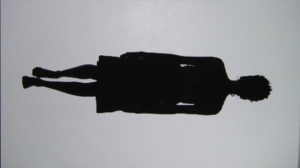
The green screen and the blue screen, they’ve come back in later works. I was really interested in the inversion of the space that is created, or this space that is maintained and lit in order for something to be created, the inversion of that type of thing. It was an exploration. My friend was wearing a Dutch wax [batik] cloth dress. All of those beautiful details in the dress started to pop within the inversion, which was what was happening. Other works in that series, the final pieces that everyone sees, are all shot off of a projection. They’re not necessarily rendered in a computer. They’re shot off of that space.
A lot of times in the video, it’s all basically black-and-white until drastic movement happens. Then you see the rainbow-y kind of coloration of the light coming from the projector. With that work, I was thinking how it was also the beginning of HD, too, the possibility for artists to be able to make HD digital [rather than analog] images. People started to get digital HD TVs [with a 16:9 aspect ratio rather than a 4:3 aspect ratio of older analog video] and things like that. I was playing with the aspect ratios, and I was thinking oh, this doesn’t feel like television anymore. It feels like film. And I wonder when will people think [about how] this was actually made. I was trying to think about images in between time and space that could digitally move in between time and space, because the time signature was different [between digital and analog video].
That’s what I was thinking about when I was making the work. The performer, who’s an amazing artist in her own right, Dionne Lee. Her work was just featured in a photo show at MoMA. She’s fantastic. She’s a black woman in my work called Black Girl as a Landscape, because the figure is inverted. Her skin color becomes shrouded in blackness. To be honest, I have a lot of thoughts about that early work, how I’ve theorized it and all of those things. I think the most interesting thing about it now, at my thirty-five years, or thirty-four years of age, is why I was making it at the time. Previous to coming back to school, I had an internship with Kalup Linzy, whose work, again, changed my life. He puts black and brown people in all his work. He puts himself in his work. I was obsessed with his practice. I was reading interview after interview. He never talked about putting black and brown people in his work.
That was what I was looking for. I was waiting to hear about why he was doing that, and he never talked about it. I was like, huh, that’s interesting. You could just do it. So, I went back to school. I wasn’t making figurative work at the time. But I was like, if I do make figurative work, I’m just going to put black and brown people in my work. And then I did, and then people stopped talking. And it became a whole thing. I’m happy I did it. That’s how I feel. That’s how I tend to speak about that work now, around how it got made and why.
BL: Let’s now turn to one other work from that early period. It’s your 42 Black Panther Balloons on 125th Street from 2014. To me it’s both playful and somewhat sardonic, because you have many references in there. In the video, you appear to be merrily walking along the sidewalk of a lively Harlem Street, while you’re carrying a bunch of black, Mylar, helium-filled Panther-shape balloons. Is there a tongue-in-cheek reference to the politics of the 60s?
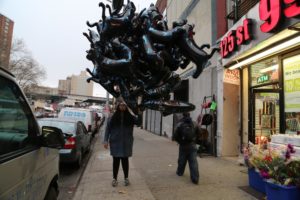
SP: The reason why I found those balloons is because a couple years previous to that, I was actually collecting vintage pins, Black Power movement pins, the kind that you pin on your shirt, such as Free Angela pins and union worker, solidarity pins, and things like that. I was just kind of interested in those histories. I wanted a tangible part of them, and those pins were really inexpensive. It was kind of interesting just to hold a thing that was connected to someone’s body. I don’t know. Then I stopped after a while. But eBay kept that search on, so one day I went back on eBay, and it had all of this Black Power movement paraphernalia. It had a notice that said, Black Panther balloon. I was like huh, this is interesting. I was like well, I have to buy those balloons. It’s like one of these things is not like the other. It’s like here’s a sign… or not a sign. Here’s a program from a rally in Southern California. Then here’s a Free Angela pin. And then here’s this other piece of paraphernalia that’s really important to history. And then here’s a balloon.
This was super, duper weird. And I just bought the balloons. They were the cheapest thing on the page. I bought fifty of them, or something like that. I was in grad school at Columbia at the time. Before that, I was interning at The Studio Museum in Harlem in the curatorial department, which was an amazing experience. Being there I found out that I didn’t want to be a curator, which was really good, because maybe I would’ve been flirting with it for my whole life, thinking oh, I could’ve… But it was an amazing experience working there. Part of that experience was getting off of the train, and then being on 125th Street. I’m from New Jersey, and there is a mythos around Harlem as a black mecca. The fact that I was working in this black mecca was just so amazing. I felt so privileged working in an art space that was surrounded by black people.
It was an amazing experience to be working at the Studio Museum, because it showed work by black artists, and it felt like it was a space for black people to see that work. And then, I was three blocks, or four blocks away in graduate school at Columbia, and being there was a completely different experience, completely different implications. When you go into those spaces as a working-class person, you kind of bump up against a kind of petty bourgeoisie. It was just like a completely different experience of that same space. It felt like that page on eBay with all of this paraphernalia, not the thing itself, not the Black Power movement itself, but paraphernalia and then something that looks similar, but is not the same at all.
I think the cheekiness, it’s like an internal cheekiness. It’s like okay, so balloons make people happy; um, Black Panther balloons, let’s just see what happens. That was the extent. For that work, I don’t know if you saw this version of it, but I had my grandmother sing “The Guns of Brixton,” the Clash version of the song. It was on a tape player. The balloons were connected to this kind of tape player. And we’re laughing throughout. Every time I listen to that, which is also in another work, it’s very eerie to me. I’m very interested in when a cheekiness gets so close to reality that it kind of makes the goosebumps or something start popping. And a lot of times, I don’t have language to think about the work intellectually until later. But I do trust that goose bumpy thing. It doesn’t necessarily mean the work is good. It just means it’s doing something that’s challenging. It doesn’t mean it’s good. I’ll just emphasize that. But yeah, I still have kind of questions around that work.
No one really knows that I found those balloons because of my history of looking into the Black Power movement, and those things that are in relationship to people’s bodies, those pins, the paper paraphernalia, all of that stuff. I think that’s quite interesting, but there’s always this question around what do you tell the audience?
BL: You just offered terrific background to your work. Let’s now turn to when you and I met. You were just finishing your new genres MFA at Columbia, and you had a residency at Recess Art in lower Manhattan. I think you were heading off to a residency in Houston. I’m wondering whether the residencies had an impact on the way you came to describe or think about your work?
SP: They’re incredibly practical. I personally feel the only reason I was able to continue an artistic practice outside of school was because I had an institutional backing through these residencies. I did not apply to residencies that didn’t give any type of financial support. I applied to residencies that either gave studios or stipends or something like that. They’re the reason why I have a career today. Otherwise, I would’ve had to work a full-time job and also make the work. The things that I was making at the time were really intense. Those works were full-time jobs in and of themselves. I think the things that I’m kind of “known for” all happened in a two-to-three-year period, when I was just constantly researching, editing, shooting, doing all of those things.
I think it says more about what artists need in order to be able to sustain a practice than anything else. Then when you’re not freaking out about how you’re going to pay your rent, and you’re not freaking out about having time to do something that’s on a deadline, so many things happen. Your mental health is better. You can read that Fred Moten book, and you can do all of this stuff. I feel incredibly lucky that I was able to have those opportunities, possibly because of the institutional privilege of having a degree from a place like Columbia. I am so grateful. When I had that residency in Houston. I lived in my studio, and the stipend that I got from that residency helped fund about half of that show at The Kitchen [“Resident Evil”, 2016], which otherwise would not have been possible. I don’t come from people who could let me borrow money. I don’t have the type of credit to get a credit card to put something on that. It all came out of my pocket. I did not have a gallery at the time that could split costs with me. I feel really lucky that I was able to have that type of support out of school.
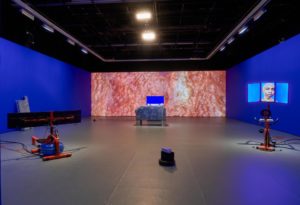
BL: I remember very clearly experiencing your two-channel projection installation, Lineage for Multiple Monitor Workstation: Number One in 2015. It premiered in the “Greater New York” survey show at MoMA PS1. I was traipsing through the building to see work, and I was totally blown away when I entered your space on the second floor. There I was. It felt as if I had crashed landed in front of, or into, your computer screens with all of the icons lined up on the edges. It was a brilliant work. How did that come about?
SP: That means so much. Thank you so much. It just blows my mind that Barbara London fricking says this… But that work was so much fun to make. Oh, my goodness. Every artwork is different, and you find it in different ways. I think back to that couple of months when I made that work, and think oh, I would like to get back there one day. Editing for like eight hours and getting up to walk around the block. Being so excited to get back to the studio, but knowing that you needed fresh air, so you just walk around. It was one of those kinds of moments. I wanted to make a work with my entire family. I just wanted a gang of black people. I just wanted a gang of black people doing stuff together. What I knew I was interested in was when I was an undergrad and I was working with the green screen and things like that, and the theorizing came later. I was thinking okay, so what if the green screen is actually this space where there are possibilities embedded in them; but also, kind of warnings embedded in it, warnings about what it means for groups of people to do things in tandem. But then also, what’s possible? What is the revolutionary kind of possibilities of people being with each other and figuring out the identity space together?
So, I started there. Instead of thinking oh, I like the green screen, I like the blue screen. I started with okay, this is what this kind of space is to me. It made sense to employ my family as actors, because isn’t that what families do anyway? You all are creating your own mythos. You’re creating kind of these stories around lineage, not just stories, but you’re literally creating lineage with each other, all of this stuff. Also, I have amazing storytellers in my family. When I was a kid, I grew up Southern Baptist, and there’s a lot of moral things around the Bible. There was a huge thing about lying. As a kid, I didn’t understand what the difference was between lying and storytelling. We would all get together all the time, but I remember specifically in the summers we’d have big cookouts at my grandmother’s house. When it would get really late, the adults would be swimming in a little bit of alcohol, and they’d start telling these stories about their lives as young people. It was always the joke that everyone’s stories got more and more elaborate every year.
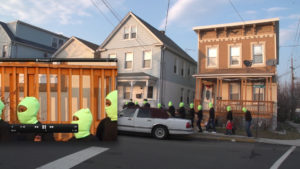
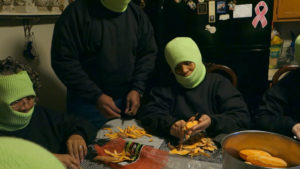
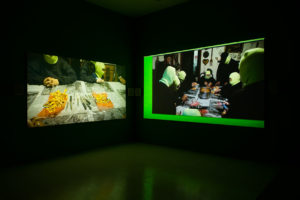
Then as a kid, I was like, well, that’s lying. You’re not supposed to lie. Then as I got older and as I became an artist, I was like oh, this is so interesting. These people are just artists. They are just spinning it, and it’s entertaining, and oh my goodness gracious. So, I just wanted them to do that. I wanted them to tell these stories together. So, I set up rituals. I call it the dimension effect. Not something that we would do, but if we were in an alternative dimension that was right next to ours, we might do it. We set up all these things, and I had them wear these [knitted, balaclava] masks that approximated the chroma key green color. I shot as much stuff as I could. As many artists do, we shoot a lot of things. Three-fourths of what I shot is not in that video. Then I moved back into the editing space, and I didn’t know what I was going to do. But I had all of this stuff that I was making edits with. I would play them all at the same time on both screens.
I started with looking at it, and I was like, this is quite interesting. This format is really interesting. So, I wound up doing performances in my studio with all of these pieces of video on the screen, as a way to kind of workshop what was happening there. I realized that the performance was actually the video. So, I turned the performances I was doing in my studio, walking through the pieces of footage into the video, calling it Lineage for a Multiple-Monitor Workstation because I was working on a two-monitor workstation editing the whole thing together.
BL: It’s a spectacular work.
SP: Thank you.
BL: Let’s turn to a work you did with your twin brother, and that’s It’s in the Game (2017).
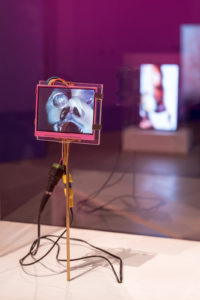
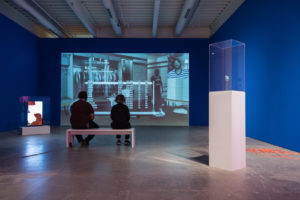
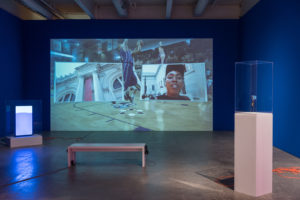
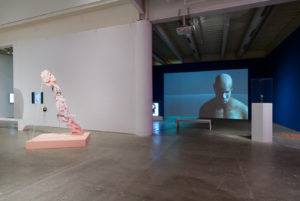
BL: You developed a narrative around his experiences that came out of his being a Division 1 basketball player for Georgia State University. This segues into something else. His physical likeness and statistics had been sold by the National Collegiate Athletic Association to the video game developer, EA sports, for use in the 2009, 2010 NCAA video games, all without his consent. I’m curious, what issues were you interested in exploring in the realm of digital bodies? Because there it’s your brother, and in the work it’s really interesting because you actually go into a museum together, and there’s a little bit of art history in there. It’s also the digital, which is what you really got into, I think, after this work. Do you want to tell me a little bit about this piece and then where it took you?
SP: That piece opened up so, so, so much that I’m still trying to figure out. The work was really interesting because I found the article about the incident. Then I asked my brother if he knew about it, and discovered he was a part of the lawsuit. Then we started talking about his experience at school, those types of things. We go to museums together and stuff for fun, especially those encyclopedic museums that have everything, like The Met. I was thinking about the objects in those museums, on sites like Thingiverse and Sketchfab, which are sites where you can upload 3D photo scans of objects. It kind of seemed strange to me that that would be possible, knowing that there are so many people, nations, fighting for the free patriation of objects in those collections.
It made me think there’s this kind of weird phantom zone about the digital likeness of these things that are intrinsically connected to the physical kind of likeness. When the digital likeness is created by the space that occupied and took the things, they’re almost saying it’s like we have so much ownership over it that we can give it to you for free. It’s quite bizarre. Is it the same as my brother and these players having their likenesses stolen? I don’t think it’s the same, but I think it’s a similar kind of hubris, which is we have access to this thing that we can take and use in whatever way. We have access to your statistics. We have access to what your skin color looks like, and we can use it because we have ownership over this.
That has opened up a lot of my interest in how our data is being used, but then it kind of skidded and turned a corner into thinking about the infrastructures of our digital technologies; thinking about the relationship of railroads and fiber optics, in relationship to museum collections; thinking about imperialism and colonialism and what happens when imperialism happens, which is the imperialists put in the means to take things out of that country, take raw materials out of those spaces. That’s where railroads come in. Then later on communication systems go in that same place. Those communication systems are directly related to our digital technologies. It’s opened up this whole kind of relationship to the underground to mining, to travel and movement of goods, all of that type of stuff. That’s what I’m actually doing some research in now.
BL: Exciting. I’ve heard that you’re a formidable teacher. When you are with students, you tell them, “Be fierce, be yourself, and don’t be intimidated. Break down the power constructs.” To me, that’s the greatest gift that you could ever give a student, words like that. I’m curious, who are you talking to now about your own artwork? You’re not in school. You’re not in a residency. I’m curious who you’re talking to.
SP: My mom. But also, my friends, my friend, Elle Perez. I talk to them about my work. I was in a fellowship where I had the amazing opportunity to speak with Kathryn Yusoff, who is the writer of A Billion Black Anthropocenes or None. That has been really informative to the work that I’m doing research on now. Those are the people I’m talking to about the work. But honestly, I need to talk to more people about my work. It’s interesting talking to students about work. You leave one of those studio visits thinking dag, I really need that too. You start questioning your aloneness in the studio.
BL: That’s very important. This is my very last question, and it’s something I’m asking each of the guests in the series. Given the ups and downs of the last eighteen months, and the struggles we’ve all faced in trying to adapt, I’m curious. How has technology affected you and your practice?
SP: Great question. Well, it’s made me really cognizant of my distance or closeness to different types of work. My class consciousness has boosted up the roof, out of the roof because of my relationship to distance, to distanced work, to working at home. I worked at home the whole pandemic, and it’s still happening. Everything that I needed had the ability to come to my door. I’ve been thinking about that, about the fact that if this was five years ago, I would be the person bringing all the things to my door, which has been quite interesting and a little devastating. But when it comes to my studio practice, I would say that it’s kind of in a weird way actually brought me a deeper into my body, some ways good, some ways not so good. I suffer with migraines. I’ve had a lot more of them because I’m in front of a screen more, and I’ve even had this conversation with, bless their hearts, all of my digital-creator students, people who have been like, “Oh, this should be fine for you because you work with computers.”
And it’s just like no, if you have to do everything in front of your computer and then also make your work, oh my goodness gracious. It’s so tough. But what’s opened up is these esoteric kind of ways of thinking about communication through technological needs. I’ve been thinking a lot about astral projection. I’ve been thinking about how could I visit my grandma without getting her sick? Astral projection, which is about leaving your body. But the only reason I’m thinking about that is because I have Zoom, which is putting me face-to-face with these people. But it’s actually putting me back into thinking about my relationship to my body in a weird way. I know that seems a little kind of ridiculous to say.
So, in conclusion, it’s boosted my class awareness a lot. It has pushed me into my body in ways of feeling kind of sick, because it’s not great to be in front of a computer. But it’s also brought me into this space of thinking through how the spiritual or how these ways of thinking about kind of the paranormal or the esoteric. Those types of things can be, not an alternative, but kind of hitched on, like a hitchhiker, to these questions that I have around technology and data, and also the unquantifiable. Lately I’ve been thinking a lot about what the unquantifiable is inside of these technologies, what it means to have a virtual background that blacks out half of your face. Those types of things are quite interesting, things that look really spooky. It’s like a paranormal hitchhiker at your next Zoom meeting. In those ways it’s been quite fun to think about those types of interventions.
BL: Sounds great. It’ll be very exciting to see where all of this takes you. Knowing that you are a very creative, talented person, it’ll be rewarding for us, for me and your audience. I want to thank you very much for spending the time and sharing all your thoughts. It’s very, very special. Thank you.
SP: Thank you.
—
Support for Barbara London Calling 2.0 is generously provided by the Kramlich Art Foundation.
Be sure to like and subscribe to Barbara London Calling so you can keep up with all the latest episodes. Follow us on Instagram at @Barbara_London_Calling and check out barbaralondon.net for transcripts of each episode and links to the works discussed.
The series is produced by Ryan Leahey, with production assistant Vuk Vuković. Web design by Vivian Selbo. Special thanks to Lee Ranaldo for graciously providing our music.
This conversation was recorded August 24, 2021; it has been edited for length and clarity.
Images

